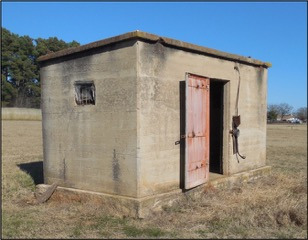Arp TX Calaboose. (original) (raw)
Arp was a quiet East Texas town until the oil boom of the early 1930s. The prospects for work it created brought hundreds of people to the area and many lived in virtual tent cities and stayed as long as there were jobs. Along with the influx of workers was an increase in crime. It is not known if there was a direct correlation between the changes brought about by the hoards of transients and the construction of the new calaboose. In any case, the city fathers authorized the construction of a new jail and it was erected near the corner of Main and North Longview streets in city block 22 sometime after 1931. The only Sanborn fire insurance map available for Arp is dated 1939 the calaboose is depicted on Sheet at the location mentioned above.

Arp Calaboose
Photo courtesy Bill Moore
The new calaboose was made of concrete using the poured in place method, a common type of construction at the time. The floor plan is a rectangular structure that measures 8 feet across the front and back and 16 feet on the sides (128 square feet) that rests on a concrete slab 13 inches thick. The door is in the center of the calaboose and it opens to a small room or vestibule that is flanked on each side by a single cell that is 57 square feet in size. The current door is a replica that the owner (Paul Arnold) paid to have fabricated. It is 38 inches by 78 inches in size. The original door was wood with no window or opening of any kind.
The primary source of direct light and ventilation to the cells is a small window on each side of the calaboose (15? x 20?). These windows have metal bars placed vertically within a wooden frame. Each cell had a small closet-like area that housed a toilet. On the wall facing the door there was a small window (12" x 12") that provided light into the bathrooms. Electricity was provided for the common room or entry area but not for the cells. The only light fixture is in the common room or vestibule.
In the early 1960s, the decision was made to demolish the Arp State Bank and build a new one on a different site. Before the new bank could be constructed the old calaboose had to be demolished or removed. The first option would create an enormous pile of rubble and that was considered undesirable. Hugh Anderson was the Chairman of the Board of Arp State Bank and he came up with the idea of moving it to a different location. He was convinced that the large oil trucks could handle the job. Paul Arnold's father, Loys Arnold, told Anderson that if they could get it onto the trucks it could be put on his son's farm approximately 1.5 miles from town. They were successful and it rests today on a pasture owned by Paul Arnold.
@ Bill Moore
November 11, 2015 guest column
Author/Photographer's Note:
"I have been documenting calabooses for over two years and this is one of the more interesting ones because of how it was rescued from demolition. [Visit] my calaboose website -
www.tinytexasjails.com." - Bill Moore, September 01, 2015
Texas Escapes, in its purpose to preserve historic, endangered and vanishing Texas, asks that anyone wishing to share their local history, stories, landmarks and recent or vintage photos, please contact us.